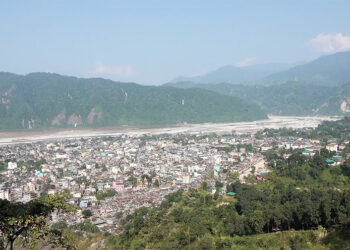 The World Bank’s latest “Country Climate and Development Report for Bhutan” lauded the country’s environmental preservation efforts. However, it pointed out room for improvement in areas such as economic diversification and building climate-resilient infrastructure. The report, released in Thimphu, serves as a key tool that brings climate and development together to help countries plan more effectively for the future.
The World Bank’s latest “Country Climate and Development Report for Bhutan” lauded the country’s environmental preservation efforts. However, it pointed out room for improvement in areas such as economic diversification and building climate-resilient infrastructure. The report, released in Thimphu, serves as a key tool that brings climate and development together to help countries plan more effectively for the future.
To diversify the economy, the report highlights the need to collaboratively engage the private sector through public financing for balanced development.
Similarly, the report underlines that focusing solely on hydro infrastructure can negatively impact the growth of other sectors. The World Bank is suggesting that Bhutan to equally focus on building the resilience of the agriculture, forestry and tourism sectors.
According to World Bank officials, the country must work on mitigating climate-change induced risks such as heavier rain, landslides and rising temperatures for enhanced resilience and a sustainable future.
“Bhutan needs to consider integrated climate risk management and resilience in infrastructure building coupled with increasing the potential and resilience in sectors which are already doing well like in hydropower, tourism, climate smart agriculture and forestry which will lead to new engines of growth, create green jobs and also strengthen the resilience of the economy to the various shocks that we show will impact GDP,” said Rangeet Gosh, Senior Economist, World Bank.
Additionally, the report highlights that despite the opportunity Bhutan has to tap into green financing and access carbon markets, there’s still a lot of unused potential when it comes to creating green jobs.
“Civil engineers play a critical role in hydropower development and dam design. Geologists, climate advisors, many such occupations which we identified, we find that there is scope for these occupations to play a greater role in the economy. Currently, they can’t do that. That again is a job that the private and public sectors both can do,” added Rangeet Gosh, Senior Economist, World Bank.
The report helps countries figure out the best ways to cut emissions and adapt to climate change while still growing their economies.
“They are really a foundational piece to locate both the risks associated with climate change, but also the opportunities, and to marry the analysis around climate risks and development trajectories. With the climate changes, it can lead to better agricultural outcomes and a longer tourism season,” said Cecile Fruman, Acting Country Director, World Bank Bhutan.
Based on solid research, the report highlights practical and impactful actions aimed at guiding governments, businesses, and development partners.
It also helps attract funding for major climate projects and shape future World Bank support for countries.
Kelzang Chhophyel
Edited by Phub Gyem










